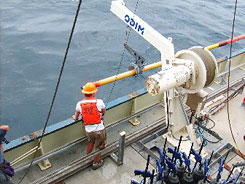

 | |||||||||||||
|
|
Journals 2008/2009Cheryl Manning
January 15, 2009 We have core! Sometime in the early morning hours, the coring crew pulled up the rig and it was full of sticky gray green mud! The night crew had already started processing it: cutting it into 1.5 m pieces, cutting off 5 cm sections of each for pore water chemistry and 30 cm for microbiology. The rest go to the sedimentology station for Rachel and I to describe. We use a circular saw to cut the core lengthwise on both sides then a piece of wire is run between the cuts to separate the mud. One half of the split core is archived in cold storage, the other is described. Each long core creates 24 sections, and it takes about an hour to describe each section. We have to have it all described and the data entered before the next site which we will reach early Saturday morning. The sediment is a calcareous ooze with layers of foraminifera. The number of forams decrease with depth. (If they were there, they have dissolved away.) Under higher magnification, we were able to identify radiolarians and diatoms, nanofossils that make shells out of silica. There were layers that had been burrowed by some critter, a worm maybe. In the third section down from the top, I found a 2 cm layer of volcanic ash! Because the chemistry of the pore fluids (aka interstitial water) is the focus of this trip, we collected porosity samples. I also collected lithologic samples from each section for Dr. Lew Abrams at University of North Carolina at Wilmington. We are also measuring the vertical conductivity of the core. The conductivity helps the chemists determine how readily the ions in the fluid move vertically. To measure it, I place a temperature probe and a conductivity meter every 10 cm along the cores length. Electrical conductivity of seawater is dependent on temperature. As temperature goes down, the conductivity goes up. All the data is organized so that if any of the microbiologists or chemists start seeing unusual changes in the data, they can look at the sedimentology and see if there is a physical reason for unusual data. The night crew will work on descriptions and tomorrow we will figure out what's next.
Questions:
|
||||||||||||

